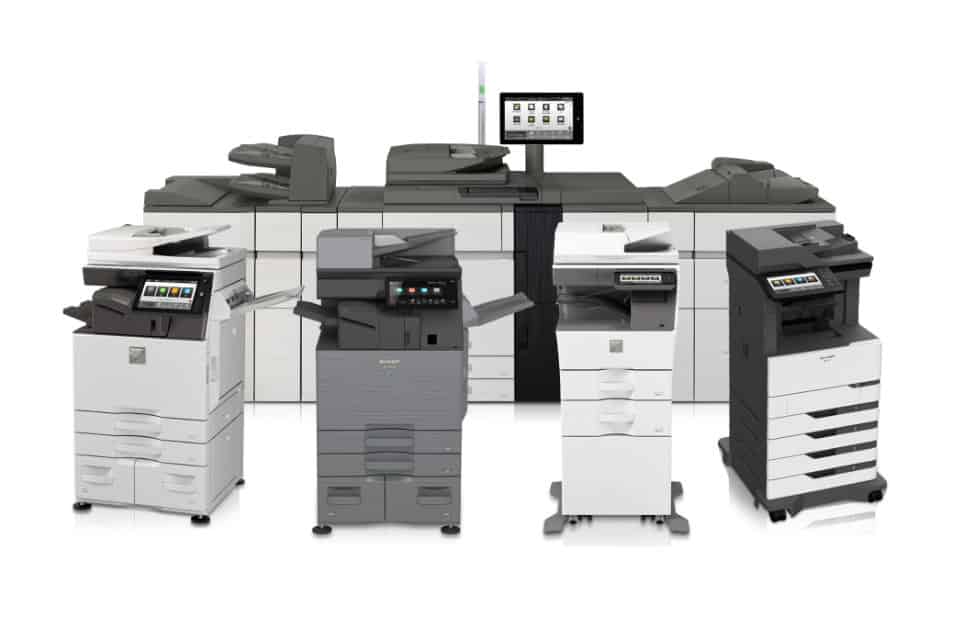Let’s face it. Copiers aren’t very exciting to most people. They’re expensive purchases with long term repercussions (or benefits!) and most people don’t know how a copier lease works. So it’s understandable that there’s a lot of myths and misinformation out there. In this article, we aim to debunk some common misconceptions regarding MFPs, shedding light on the facts to help users make informed decisions and optimize their usage.
Myth #1 – MFPs Always Have Issues
We’ve all been there when an MFP malfunctions. Whether it’s a paper jam, it’s out of toner, or it’s painfully slow – in fact, worker frustration with printer technology is legendary. Remember Office Space? Sometimes you just want to be a gangster.
Some reasons your copiers may misbehave include outdated software, improper maintenance, low-quality supplies, or network connectivity issues. Copiers have a lifespan as with any piece of equipment, and as technology advances, older models become less efficient and reliable. This is why copier dealers will increase the cost of maintenance every year – older machines just require more parts and labor.
But that doesn’t mean that mechanical problems should be significant. MFPs are rated in duty cycles and manufacturers sell Preventive Maintenance kits to be installed when major milestones have been reached. You can think of them like the “big service” that is recommended when you car gets near 150,000 miles. You’re likely to need a timing chain or belt and the engine gets valves adjusted, A good mechanic is also going to suggest replacing hard to get to items like your water pump, tensioner pully, thermostat, changing antifreeze, etc. Since you’re already paying for labor to remove them, you can replace these parts much cheaper than if you wait for them to fail and your car leaves you stranded.
MFP service calls should be minimal for a 5 year lifecycle. If you’re trying to breathe life into a 10 year old MFP, everything is likely worn and parts are probably drying up in the channel. Of course you’re going to have a bad time. If you’re on year 3, you need to figure out if you have a lemon, your dealer significantly undersold you a copier in order to be the cheap guy, or you’re now using it in a way that vastly exceeds it’s expected lifecycle.
Outdated copiers often can’t keep up with the demands of a busy office, resulting in frequent paper jams, slower printing speeds, and lower-quality outputs. Upgrading to a newer model can lead to improved efficiency, reduced maintenance costs and access to advanced features that benefit your business.
Myth #2 – Printers are Cheaper than Big Copiers
This is true, only if it’s a convenience printer that doesn’t get much usage.
In order to assess the real cost of the little copier, you have the acquisition cost, installation cost, and the cost for printing pages.
Printers typically have shorter service lives than MFPs. Manufacturers provide a relatively short warranty period and they don’t guarantee driver updates for a very long time. Less maintenance parts exist in the channel, and it’s really easy to find a situation where it costs more to repair a printer than to replace it. Toner and ink yields are also bad. Expect a desktop printer to get replaced every 3 years or so. And in today’s market you can get black and white copies for well under a penny each with decent volume. Some of these “cheap” printers and fax machines are near $0.05.
You’ll also find very little chance at a productivity boost with a cheap printer. If you happen to get a printer with a scanner, you might get 10 – 20 images per minute on the scanner. With a good MFP, you could be scanning both sides of the page in 1 pass, capturing up to 100 images per minute *and* getting optical character recognition (OCR) *and* attaching that image to line of business software or sending it to the cloud in the same amount of time!
We once did a custom OSA application for Sharp MFPs for a local eyeglass provider, and they estimated saving nearly $40,000 per year in labor hours because our copiers were scanning right into medical records. A process that took 5 minutes at best was taken to about 15 seconds. It didn’t take long for the backlog of paperwork waiting for scanning to disappear, and deploying the right fleet of copiers was way cheaper than hiring a clerk. With organizations moving workloads and services to the cloud, today is a great time to look at opportunities for copier integration.
Myth #3 – Bigger, More Expensive MFPs are Better
The misconception that high-priced copiers are superior is a common myth that often leads businesses astray in purchasing decisions. The reality is that the notion of superiority depends significantly on the specific needs and requirements of the user.
While premium copiers may come equipped with advanced features and cutting-edge technologies, it doesn’t necessarily mean they are the best fit for every situation. The key lies in aligning the MFP’s capabilities with the unique demands of the required workflow. In some scenarios, a less expensive model with fewer features is equally effective in meeting essential requirements without unnecessary frills. For example, why deploy a large A3 MFP when you never print tabloid paper? Unless you also need the more durable print engine to handle high volume, the smaller, less expensive A4 copier might be a better fit.
The best MFP for your business is the one that strikes a balance between functionality, cost and the specific tasks you need it to perform. Conducting a thorough assessment of your printing needs and considering the essential features required for your operations can lead to a more informed decision, ensuring that you invest in a copier that optimally serves your purposes without unnecessary expenses. It’s not always about the price tag; it’s about finding the right tool for the job.
Myth #4 – I Can’t Upgrade a Bad Copier Early
While it’s true that copier leases need to be paid in full, sometimes the best copier companies are able to help you out. You have a couple angles to make up that expense to the leasing company:
- Manufacturer Incentives – Copiers are a very competitive industry. So competitive, in fact, that there are often promotional funds available to encourage you to switch to their brand. It’s all about increasing market share….the market is saturated so you’ve got to take it from somebody else.
- Work the Leasing Company – There’s little incentive for a leasing company to let you off the hook. However, if you’re a good pay and the leasing company has a chance to keep your business, all the sudden they become much more flexible. This is especially true right now. Older leases written when interest rates were low aren’t generating the kind of returns a new lease in today’s high interest rate environment will bring. So they might be willing to lower your cost to exit your current lease to write you one at a higher interest rate.
- Lower Usage Costs – MFPs are so much more efficient than they were in the past. This is true 20 years ago, 10 years ago, and even models 5 years old. Lower printing costs can often make up and exceed the cost of leaving a copier lease early. As a Managed Print Services provider, I see this all the time.
- Wrap the Balance Due into the Next Lease – I try not to make this recommendation if I can help it. I’m going to work the first 4 options as hard as I can. But sometimes your current copier is just such a bad fit for your office that this is your best bet. This is just like being underwater on your car loan, though.
Myth #5 – A New Copier is Expensive
Deciding to invest in a new copier can be a highly cost-effective move. Newer MFPs employ advancements beyond traditional functionalities, offering a range of benefits that contribute to long-term savings and enhanced productivity.
Remember the lower usage costs mentioned earlier? If you print enough, your copier dealer has increased your rates or proposed an unethical minimum print volume, and the MFP is properly sized, it’s not uncommon for lower printing costs to offset your lease payments. Sometimes I see an overall savings on prints of 25% or more.
One significant aspect of newer MFPs is their emphasis on energy efficiency. The incorporation of advanced technologies and eco-friendly features not only aligns with sustainability goals but also results in reduced energy consumption. This translates to lower electric bills over time, contributing to the overall cost-effectiveness of the upgraded MFP.
Improved print speeds are another reason to consider upgrading. The acceleration in print speeds saves employees valuable time and increases overall efficiency in handling large print jobs or meeting tight deadlines. If your jobs are relatively small, print speed doesn’t matter much. But if you do print large reports, service bulletins for a busy church, or you’re a small copy shop print speed can save you a lot of time.
Cybersecurity is a critical concern today, and newer copier models address this by incorporating enhanced security features. With the rising importance of protecting sensitive information, features such as secure print release, antivirus software and user authentication provide an added safeguard against unauthorized access. Investing in a copier with robust security measures can mitigate potential risks and protect your business from data breaches, potentially saving significant costs associated with security incidents.

